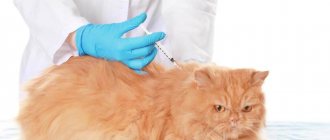In some situations, pet owners are faced with the question: how to give an injection to a cat at home? It is not always possible to seek help from a specialist. For example, you are in a country house far from civilization or your animal is prescribed a long course of injectable medications and they need to be administered several times a day. Under these circumstances, visiting a doctor becomes quite a hassle.
Giving your cat an injection is not difficult at all. To do this, you need to know some rules that will help make a subcutaneous or intramuscular injection as safe and painless as possible for the animal. In addition, if a person clearly knows what and how he should do, this will give him courage and confidence in his abilities and in the future the question will not cause you any difficulties.
Preparation
Important! Before administering any medications, be sure to consult your doctor. Use only those medications that are prescribed. Strictly follow the dosage and timing of treatment.
- Read the instructions carefully. Check the expiration date of the medicine and diluent used. Do not use ampoules with erased names. Make sure that the color and consistency of the medicine correspond to the description given in the instructions. Medicines that are prone to separation into their original components must be shaken before administration; this will also be indicated in the instructions for the drug.
- Determine your pet's weight. There are medications that require precise dosage - with a smaller dose you will not get the desired therapeutic effect, and an overestimation of the dose will cause undesirable effects or symptoms of poisoning.
- The choice of syringe depends on the dose, consistency of the drug and method of administration. Most often, 2 ml syringes are used for cats. If you need to administer a dose less than 1 ml, use an insulin syringe.
- Before the procedure, wash your hands with soap.
- There is no need to disinfect the injection site; the skin of cats has excellent protective properties, but the syringe must be sterile. When preparing the solution, do not touch the needle with your hands. If you are not injecting the medicine right away, cover the needle.
- Each injection must be given with a new sterile syringe and sterile needle. Prepare the medication solution immediately before use. Do not mix different drugs in one syringe unless prescribed by a doctor. Fill the syringe with as much medication as needed for one injection.
- Dry medicines cannot be stored after dilution; any leftovers will have to be thrown away.
- Cold medicine should not be administered; the temperature of the solution should approximately correspond to body temperature. This especially applies to oil solutions, which, when heated, pass through the needle better. To warm the ampoule with the solution, simply hold it in your hand for a few minutes.
- If the instructions for the medicine include the option of using novocaine as a solvent, be sure to use this. In this case, the injection will be less painful for the animal and it will tolerate it more calmly. Novocaine, as a solvent, is best used not in its pure form, but with the addition of saline or water for injection; see the instructions for the drug for details.
- After you have drawn the medication into the syringe, turn the needle up and release a small amount of medication to remove any air bubbles from the syringe. If you couldn’t remove them completely, it’s okay, just don’t inject any remaining medicine with bubbles during the injection.
- Set yourself in a calm and decisive mood, don’t worry, the animal shouldn’t feel that you’re nervous. In order not to scare the cat, it is better to give the injection without lengthy preparation, calmly and confidently. You can first practice on inanimate objects, for example on a pillow, what and how you will do
- For the first time, take someone's help. Have a helper hold your cat lightly while you administer the injection. If the cat is calm, in the future you will be able to do everything yourself.
Rules
The main rule mentioned above is cleanliness, compliance with the rules of septic tanks and antiseptics.
Some specifics:
- Only a new syringe is used for the injection.
- The needle is untouchable; it does not need to be wiped, prepared or touched.
A new needle is used for each injection because:
- during the initial puncture of the skin, burrs appear on the needle that you cannot see;
- the used needle is not sterile and even if you wipe the outside of it, it is impossible to disinfect the canal.
The injection should be beneficial, which means it is worth considering the rules for storing drugs. The best solution is a detailed consultation with a doctor, but it is not always possible, and a confused owner is not always able to remember the nuances. An opened drug always has a limited and short shelf life because it is oxidized by oxygen. If you need to make several injections from one ampoule, immediately draw the drug into new syringes. Afterwards, the syringes need to be wrapped in paper and put in the refrigerator.
Risks and bad consequences are most often caused by excitement and inattention. This algorithm will help you avoid common mistakes:
- Inspect the ampoule - it should have the name and expiration date. Do not use ampoules without inscriptions, expiration dates or with worn out letters.
- Instructions, item description of the drug - it says what the solution should look like: color, consistency, presence of sediment, etc. Found any inconsistencies? – do not use this ampoule.
- Instructions, destination – check the information to see if the drug is intended for cats and for intramuscular administration.
- Instructions, method of administration and dosage - some drugs need to be administered at a certain speed or only by heating to the desired temperature. At the same point there will be instructions if the drug needs to be prepared: diluted, shaken, etc.
The next step is to open the ampoule and withdraw the drug into a syringe. Everything is simple here - the main thing is to capture as little air as possible. A few nuances that will help you:
- Small ampoules with a neck diameter of up to 2 mm can be turned upside down and the drug will not leak out.
- From medium and large ampoules, the neck of which is more than 3 mm, it is more convenient to take the drug at an angle of 45° or by placing the ampoule on a vertical surface.
- From containers with a rubber stopper, sampling will be easier and more convenient if you use an additional needle to suck in air.
To open the ampoule, a special blade-stone is used, which is convenient for filing glass. Most modern manufacturers package drugs in ampoules with an indicator element (dot or strip). If there is an indicator on the ampoule, you need to press the top part above it and away from you. Do not apply too much force, as you may damage both the ampoule and your hands.
What to do if air does get into the syringe? Firstly, don’t worry, an air bubble that gets into a muscle is not fatal, and secondly, it can be expelled through a needle. Simply lift the syringe with the needle up, tap the plastic, and when the bubbles rise, apply a little pressure on the plunger.
Places to give an injection to a cat
At home, you can do a subcutaneous and intramuscular injection. All other methods of administration - intradermal, intravenous, intraarterial, intraosseous - are possible only in a clinical setting performed by an experienced specialist.
Surfaces for drug administration:
- Medicines can be injected subcutaneously
- Intramuscularly - into the muscles of the thigh and shoulder.
Sites for injections under the skin and intramuscularly are shown in the figure below.
How to give a hypodermic injection to a cat
For subcutaneous administration, it is better to use syringes with a volume of 2 or 3 ml. If you need to inject a medicine in a dose of less than 1 ml, use a syringe to inject insulin, replacing the needle on it. The needle from an insulin syringe is too thin and short for subcutaneous injection into a cat, so it is better to take a needle from a 2 gram syringe. When administering drugs subcutaneously, adhere to the general rules for preparing for injection given above. An injection under the skin is often made in the withers area; this area is less sensitive to pain.
Rate of drug administration
It depends on the volume of the medicine, as well as on its thickness. Aqueous solutions are injected at an average rate of 1 ml per 1 second, and oily or viscous solutions - the same volume in 5-7 seconds.
If all the instructions presented are difficult for you to perceive in text form, then you can watch a video on how to give an injection to a cat.
How to give an injection at the withers
Before the injection, caress and stroke the animal. Speak calmly and friendly. Hold the cat with the forearm of your right hand, pressing it lightly. If you are injecting with an assistant, then have him press the shoulders with the head with one hand, and the backside with the other, to the surface on which the animal is lying. Take the syringe with the prepared medicine with your right hand, and form a skin fold with your left. To do this, pull the skin with your left hand.
Pierce the skin with a confident movement, aiming the needle under the base of the fold and parallel to the body. The needle is inserted 1 - 2 cm long, not perpendicular to the fold, but at an angle. The skin in the withers area is quite dense and to pierce it you need to apply some force. After the puncture, administer the medicine; the speed of administration for subcutaneous injections does not matter.
Be careful not to puncture the fold of skin all the way through, otherwise the medicine will leak out from the opposite side and you will have to repeat the injection.
Without releasing the fold, remove the needle and syringe. The injection site can be lightly massaged so that the medicine spreads evenly under the skin and does not flow out through the injection hole.
In one subcutaneous injection, significant volumes of drug solutions can be administered - from 30 to 60 ml, depending on live weight.
Heat
A slight increase in the animal’s body temperature after injection is considered an adequate reaction of the body.
- But if the high temperature persists for more than 3 days, then you need to immediately go to the veterinary clinic.
- Typically, this complication is associated with an allergy to a drug or the development of an inflammatory process.
We hope that this material was useful to you, and now you can give your cat an injection yourself. Good luck!
How to give an intramuscular injection
Although it is easier to give a subcutaneous injection, there are a number of medications that the instructions prescribe to be administered exclusively intramuscularly. This is explained by the fact that some drugs do not disperse well when injected subcutaneously or are irritating to the tissue.
Oil solutions and suspensions are injected intramuscularly when it is necessary to localize a certain amount of the drug in one place. Gradually dissolving, they provide a certain level of therapeutic substance in the blood for a long time - they have a prolonged effect.
Preparation for injection is the same as for subcutaneous administration. It is better to inject into the thigh area, because it is more fleshy and less likely to damage internal structures.
For intramuscular injections in cats, an insulin syringe is well suited. The diameter of its needle is smaller, so there is less tissue injury, and the short length will not allow it to be inserted too deeply into the tissue. This option is applicable when administering most medicinal solutions, with the exception of thick oil-based solutions, which are difficult to pass through the thin needle of an insulin syringe.
It is advisable to give an intramuscular injection to a fixed animal. The injection is more painful than the subcutaneous injection, so the cat may jerk or escape during the procedure.
The procedure is ongoing
Without a doubt, the injection is unpleasant for animals and causes them considerable discomfort. Unfortunately, situations may arise when the injection must be given continuously over a certain period of time. In this case, it is worth taking care of maximum comfort for the pet in order to avoid prolonged stress.
It will not be possible to train your pet to endure pain, but there is an opportunity for associative perception:
- Injections into the cat's thigh should be done at the same hours and in the same environment.
- The pet must be in a calm state of mind.
- Immediately before the procedure, you should begin to establish contact with the animal: stroke it, caress it.
- After the injection, be sure to praise your pet and give him his favorite treat.
Following these recommendations will help the animal endure discomfort more patiently and be calmer.
How to give an injection in the thigh
The assistant fixes the cat, as in the first case, firmly pressing the front and back parts of the body to a flat and hard surface.
The injection is given in the back of the thigh. Before insertion, grasp the inside of your thigh and stretch the skin until it becomes tense. The needle is inserted at an angle to the surface to a depth of about 1 cm.
When introducing oil solutions or suspensions (for example, bicillin), they should not be allowed to enter the vessel. Therefore, after inserting the needle into the muscle, pull the plunger back a little and make sure that there is no blood in the syringe body. If it gets into a vessel, remove the needle and repeat the injection again.
If everything is fine and there is no blood in the syringe, slowly inject the medicine. Slow intramuscular injection is not as painful and causes less tissue damage.
The cat is released only after the needle is removed. During a course of treatment, injections are given alternately, in one or the other thigh.
Types of injections
The injection location depends on the type of medicine. The drug can be injected subcutaneously, into a muscle or into a vein. In the first case, the injection is placed in the withers or in the skin fold under the shoulder blade or on the knee of the hind paw. Intramuscular injections are given in the thigh or shoulder. The most difficult type of injection is intravenous, as it requires a catheter.
There are practically no nerve endings at the withers and the cat feels an injection here less than in the thigh or under the shoulder blade.
Subcutaneous injection
The advantage of this method is its relative painlessness (compared to intramuscular and intravenous injections). The downside is the poor absorption of the drug due to insufficient peripheral circulation (that is, the effect of the drug will be 2-3 times weaker than when administered into a muscle or vein)
In addition, it is important to ensure that the next injection is not given in the same place as the previous injection. The fact is that repeated injections into one point cause atrophy of adipose tissue and lead to impaired absorption of the drug
A subcutaneous injection is less effective compared to intramuscular and intravenous injections, but the cat feels almost no pain from the skin puncture
Where is the withers located?
A subcutaneous injection can be given in the fold under the shoulder blade or on the knee of the hind leg, but it is recommended to inject the product into the withers. There are few nerve endings here, so the procedure will be the most painless for the cat. Finding the withers is simple: this place is where the shoulder blades of the cat's front legs meet. It is covered with a fairly dense fold of skin, which can be easily pulled upward with your fingers.
The cat holds the cat by the withers during mating, and the cat carries her kittens
Instructions on how to give a subcutaneous injection
First, you should pinch the fold of skin and pull it up until it is completely straightened (you don’t need to take a very thick fold, a thickness of 5–7 mm is enough). A syringe is used to make a puncture at the base of the fold; you only need to insert the tip of the needle so as not to pierce the fold through. The needle must be directed parallel to the spinal column. When the injection is completed, then, without ceasing to hold the skin, remove the needle and only then release the skin fold.
Video about subcutaneous injections
How is an intramuscular injection done?
This method is suitable for most pharmaceuticals, including those with delayed and cumulative effects (penicillins, antipsychotics, steroids, etc.). Absorption occurs faster than when the medicine is injected into the withers, but slower than with intravenous injections. The main disadvantage is the painfulness of the procedure.
The best place for an intramuscular injection is the thigh. An injection into the shoulder is allowed. Before the procedure, you need to make sure that the muscle is as relaxed as possible. If the cat is worried and his body is too tense, you need to wait until the animal calms down. Then you should lightly pinch and pull the skin, pierce it with the tip of the needle. Before administering the medicine, pull the plunger slightly towards you. If blood begins to seep into the syringe, it means you have entered a vessel and you need to choose a new injection site. The needle is inserted at an angle of 45 degrees no deeper than 1.5 centimeters.
Injections are placed from the back of the paws, since when piercing the front, there is a high risk of affecting a nerve or getting into a joint.
Video about injections in the thigh
Intravenous drug administration
With intravenous injections, the medicine quickly enters the bloodstream and reaches the brain, liver, heart, lungs, kidneys and other internal organs. It is used in emergency situations when the most rapid relief of symptoms that threaten the cat’s life is required. A catheter is used to administer the drug:
- The site of the future puncture is wiped with a disinfectant.
- Press the area 0.5–1 cm below the puncture site with a finger or tourniquet and slowly insert the needle at an angle of 15 degrees.
- Having fixed the stylet, slowly advance the catheter into the vein, and then remove the needle.
- Close the plug or immediately attach the infusion block with the medicine.
- The catheter is secured to the cat's paw with a patch or elastic bandage.
You cannot carry out catheterization yourself at home - it should only be done by a veterinarian. The procedure is complex and requires precision in every action. Even the slightest mistake can cause complications (for example, vein injury, blood clots, or infection in the wound).
Catheters allow you to place single intravenous injections or connect IVs
After the injection, the cat limps - is this normal?
Like humans, cats may experience temporary lameness after the administration of certain medications. This is completely normal and there is nothing wrong with it. After a few minutes, the pain or numbness will subside and the limp will disappear.
It should also be mentioned that cats are quite artistic in nature and can feign their “suffering” a little longer than it actually occurs. At the same time, the cat tries to show the owner with all her appearance how “terribly” she is in pain and how wrong he is for doing this to her. Make amends for “your guilt”, give her something tasty and, perhaps, she will be more loyal to your “rash” act.
If the cat stops stepping on the paw and pulls it up, you need to consult a doctor; perhaps during the injection the needle got into the nerve plexus, in which case you will have to undergo a course of novocaine therapy.
You should also consult a doctor if a painful, hot swelling or any hard or soft lumps have formed at the injection site, or if your general condition has worsened.
Possible complications
As a rule, injections do not cause negative consequences. But sometimes they can arise not only from an inexperienced owner, but also from a specialist. It is important to know about possible complications in order to provide your pet with the necessary help in a timely manner.
If you inject your cat incorrectly, for example, by injecting the drug into the wrong place, damaging a blood vessel, or hitting a nerve, problems may include the following:
- If at the injection site after removing the needle drops of blood appeared
, then this indicates damage to the wall of the blood vessel. If a few drops of blood are released, then to stop the bleeding it is enough to apply cold to the injection site for 10-15 minutes (ice or a frozen product from the freezer, wrapped in a clean cloth or a damp, cold towel).
- Infiltration or compaction
(bump, swelling) at the injection site indicates that the injected medicine is not absorbed into the bloodstream, or an inflammatory process has begun in the injured tissue or surrounding tissues. The causes of infiltration may be: the introduction of too much of the drug at once, infection along with it, very rapid administration of the drug, an allergic reaction of tissues, the use of drugs without prior warming to body temperature. What to do in such a situation? If the infiltrate does not resolve, does not go away for a long time, the area of compaction becomes hot, painful, increases in size, the animal’s well-being worsens, it is necessary to show the cat to a veterinarian.
- Long-term non-absorbable infiltrates and compactions can lead to the occurrence of abscesses
. A purulent inflammation forms in the infiltrate cavity or at the site of compaction; the injection site may swell, become hot and painful. The cat may refuse to eat, become lethargic, apathetic, and its body temperature will rise. This condition is dangerous and in severe cases can lead to sepsis and death of the animal. It is important to seek surgical help as soon as possible.
- Lameness after injection
. There can be several causes of lameness. One of them is muscle damage due to the use of tissue irritating solutions, antibiotics and thick, difficult to dissolve drugs, leading to severe pain at the injection site. Lameness can occur as a result of an unsuccessful injection, or as a result of a needle getting into a nerve. As a rule, lameness goes away within an hour after the injection. If the lameness intensifies and does not go away within several days, the limb has lost mobility and cannot straighten, and the cat does not lean on it when walking, it is necessary to show your pet to a doctor.
- Temperature increase.
This reaction of the body can be caused by an allergy to the injected drug, or serve as a symptom of an inflammatory process at the injection site. This can happen if sterility was not maintained during the procedure.
- Severe reaction to stress
. Cats are very sensitive animals. They have a hard time enduring long-term chronic stress, pain and discomfort. If the pet takes the injections too hard, hides after the procedures, becomes fearful and nervous, refuses to eat, does not allow itself to be touched, hides in secluded places and does not come out of them for a long time, then, in agreement with the attending physician, it is advisable to switch as soon as possible. for other forms of drug administration. For example, for tablets or suspensions. To reduce stress levels, you can use special calming synthetic facial cat pheromones in the form of a diffuser.
Pay close attention to your pet's well-being and changes in behavior. If there is refusal to eat, lethargy, fever, pain at the injection site, or bloody or purulent discharge at the injection site, immediately take your pet to a veterinarian.
The following video discusses how to properly inject a cat intramuscularly.
Blood after injection
A small amount of blood appearing at the injection site is normal, because small blood vessels are injured when a needle is inserted. In this case, blot the injection site with a cotton swab moistened with any disinfectant.
If bleeding continues, apply something cold for 15 minutes. You can put a piece of ice or snow in a plastic bag and wrap it in a piece of gauze or clean cloth and apply it to the puncture site. If this does not help, consult a doctor.
Why the back paw?
Often, beginning cat breeders do not understand why it is preferable to choose the hind limb for injections.
In fact, this choice is quite justified due to objective reasons:
- The most important reason is the abundance and thickness of muscle tissue. A normally well-fed pet has a real “ham” on its hind leg, which allows the needle to be inserted deep enough without injuring the surrounding tissue or scratching the bone. But this, again, only applies to animals with normal fat and in good physical shape. In addition, during the injection it is much more convenient to fix a normally developed muscle with your fingers.
- The gluteal and thigh muscles have a good blood supply and contract strongly when walking or running. All this contributes to the rapid and complete absorption of the drug from the site of its administration. This is very important, since when injected into weakly contracting muscles, the formation of connective tissue encapsulations and places of petrification (petrification) of tissues is possible.











